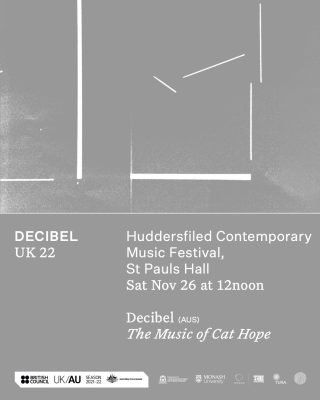The Music of Cat Hope
A selection of works by Victorian composer and Decibel founder Cat Hope, featuring the Decibel ScorePlayer app, and from the release ‘Cat Hope: Decibel’(Ezz-Thetics Switzerland, CD, 2022).
This program of works, created between 2012 and 2018, explore low frequency sound as a compositional construct and examine the timbral contrasts of electronic and acoustic timbres, with a focus on the low sine tone, or sub tone. These works also examine the potential of the line as a compositional tool, at times engaging live processing to extend concepts of liveness and metaphor.
The score for Tone Being requires the performer to ‘draw’ on the surface of the tam with different performance tools, exploring how a line can represent timbre, time and harmonic development. The sub tone draws from the frequency spectrum of the original tam that the piece was written on, and explores the timbral relationship of the low electronic sine tone against the complex sound world of the tam.
For The Lowest Drawer, three instruments are sampled in real time, processed into sine tones that sustain the pitch each instrument plays at thirteen particular moments in the piece. These tones gradually build to a chord that is different each time the piece is played, since the players can choose any note as a starting point. The instruments descend lower in pitch as the work unfolds, ending in the lowest range (drawer) of each instrument.
The title, Shadow of Mill, is taken from Phil Griffith’s paper Towards White Australia: The Shadow of Mill and the Spectre of Slavery in the 1802 debates on Chinese Immigration, an examination of the implications of the White Australia policy. A copy of this policy is used to play the cello, grated against the body and strings of the instrument to represent the importation of European Culture into Australia.
The Earth Defeats Me explores the line as notation, and how the sounds of acoustic instruments can be transformed via ‘music concrete’ processes that are returned to live performance.
Songo 102 is a homage to Italian composer Giacinto Scelsi, and the book entitled Songo 101. It features performance techniques favoured by Scelsi and engages the sampling, spectral analysis and instantaneous play back of the pitch of certain moments of live instruments. These gradually ‘drift’ away from the original pitch, offering a reflection on the recording process, which is never completely stable or reliable.
